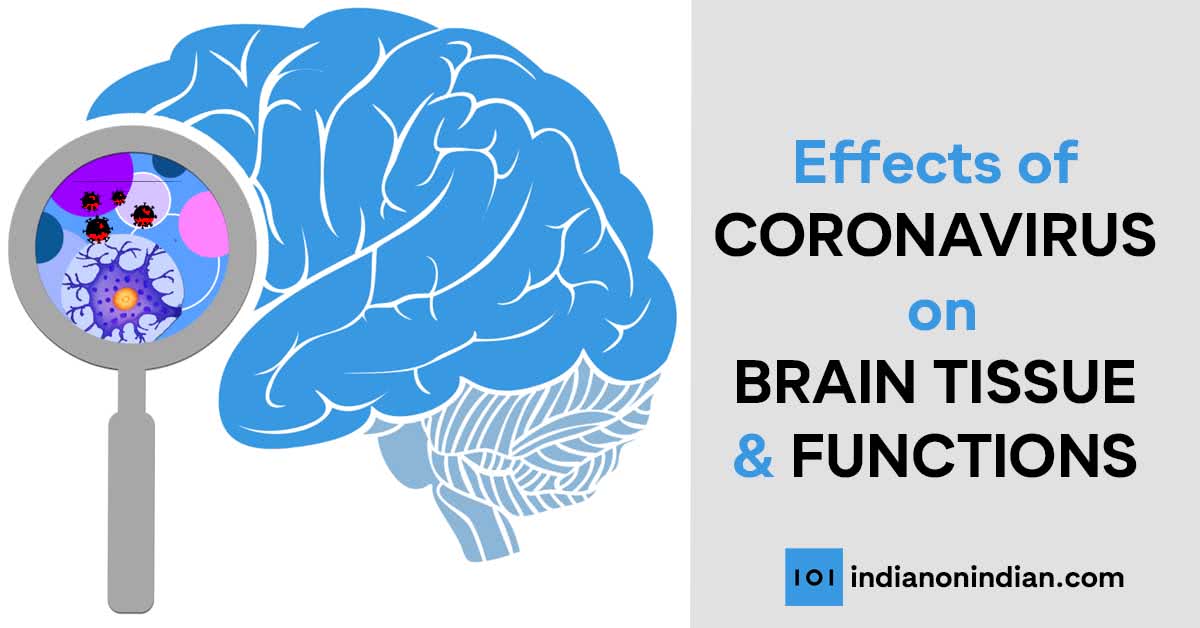Effects of Coronavirus on Brain : The COVID-19 Pandemic is the largest and most severe pandemic since the 1918 INFLUENZA Pandemic. The current outbreak of COVID-19 generally highlights respiratory symptoms, but neurological symptoms are reported too. Evidence for neurological invasion and virulence has been gathered from various human and animal studies.
Must Check: Convalescent Plasma Therapy for Critically ill Covid-19 Patients
Respiratory viruses like CORONA viruses are opportunistic pathogen infecting upper respiratory tract in humans. Some have, NEURO-INVASIVE properties activating an immune response in the brain, these immune responses can be neuroprotective or may cause long term neurodegenerative diseases.
SARS-COV-2 has been reported with some neurological manifestations such as anosmia or loss of smell as a frequent symptom, maybe due to olfactory dysfunction [OD] and initial immune responses.
The most common respiratory manifestation: hypoxia that leads to brain oedema, disturbed metabolism and other neurological manifestations. Concern for Neurological deficits posts COVID-19 arose after patients reported a loss of involuntary control of breathing, ataxia, loss of smell and convulsions or seizures. This review highlights effects of CORONA virus on the central nervous system [CNS] through theoretical data and studies carried out, by summarizing: possible routes of transmission, pathogenesis, neurological and neuropsychiatric manifestations, complications, possible treatments and conclusion.
Strains of Human Coronavirus
There are 7 strains: SARS-COV-2, SARS-COV, MERS-COV, OC43, 229E, NL63, HKU1.
Possible Routes of Transmission :
- TRANS NEURONAL ROUTE: a study on transgenic hACE-2 mice and OC43 inoculated mice showed SARS-COV-2 entry in the brain via olfactory bulb, POST intranasal inoculation.
- NEUROTRANSMITTER PATHWAY: hypothesis proposing entry of SARS-COV-2 via serotonergic dorsal raphe system.
- HEMATOGENOUS ROUTE: viral RNA has been detected in patients with SARS-COV-2, so entry to CNS by a hematogenous route through damaged Blood-Brain Barrier [ BBB ] can be a possible route.
- LYMPHATIC SYSTEMS: entry via cervical and mesenteric lymph nodes.
- LONG TERM EFFECTS POSTACUTE INFECTION: In surviving mice post hCOV-OC43 infection, 80% virus cleared, but Viral RNA persists for months, indicates the possibility of neurodegenerative sequelae. More studies are needed to know the exact effects.
- RECEPTORS / ANTIBODIES: studies have reported that SARA-COV-2 use Angiotensin-converting enzyme -2 [ ACE-2 ] as a cellular receptor, due to Spike protein [S]. Di Peptidyl transferase -4 [ DPP-4 ] or CD-26 was a cellular receptor for MERS-COV. Other possible receptors are Aminopeptidase N [ APN ] or CD-13, CD-209 L or L-SIGN.
- NEUROTROPISM: The ability of a pathogen to invade and survive in the nervous system is known as Neurotropism. CORONA viruses are neurotropic in several hosts including humans. Recent studies suggest that SARS-COV-2 transport to the brain via cribriform plate adjacent to the olfactory bulb. Early symptom favouring to this route of infection is the loss of smell reported in COVID-19 patients.
Also Check: COVID-19 Treatment in Ayurveda and Homeopathy
Pathogenesis / Mechanism: Effects of Coronavirus on Brain
It is evident that COVID-19 patients admitted in Intensive care unit [ ICU ] due to respiratory difficulties faced by them, end up with neurological symptoms too. This is now our concern to know aetiology and mechanism-based o data available. Neurological symptoms in ICU patients possibly occur due to progressive brain damage and dysfunction, elicitated by severe hypoxia and hypoxemia, SARS-COV-2 dissemination in the brain parenchyma and increased inflammation.
The virus affects mainly: Brainstem and Thalamic functions leading to sensorimotor dysfunctions and psychiatric disorders. It is noticed that SARS-COV-2 infection leads to Brain cell demyelination and degeneration in a similar way as Multiple Sclerosis [ MS ]. Data available shows SARS-COV-2 infection shows structural similarities with Multiple Sclerosis.
Also Read: Vaccines : The Magical Preparation for a Healthier Life
There is a need to evaluate Brain integrity and Cerebral area in patients recovered from long term COVID-19 infection, as it can lead to chronic Neuro-inflammation and progressive demyelination also leading to dysfunctional cerebral area post-SARS-COV-2 infection. Following this, the virus may infect the Respiratory centre of the brain, leading to the Collapse of Respiratory centre.
Secondary possible mechanisms include: Hypoxia that leads to – Respiratory failure, stimulated immune response leads to various types of encephalopathy, White matter damage, Abnormal blood clotting resulting in Stroke.
So the underlying aetiology of deadly respiratory manifestations in COVID-19 patients may be Neuro-invasion of CORONA virus. Hence, it is highly suggestive to follow up the recovered patients from long term COVID-19 infection, to evaluate their Brain integrity by neuroimaging.
Clinical Manifestations :
Neurological symptoms :
A growing number of case reports and series describe a wide range of neurological symptoms, but many have insufficient or unclear details, addressing challenges faced in studying such COVID-19 patients.
In Wuhan, China out of 214 hospitalized patients with COVID-19 positive, 93 patients reported with encephalopathy. In France, the Intensive care unit of 58 patients of COVID-19, 43 patients reported with encephalopathy. A Cohort study on 58 COVID-19 patients showed a correlation between Acute respiratory distress syndrome [ ARDS ] and encephalopathy. Gene sequencing in 56-year-old COVID-19 patient confirms SARS-COV-2 presence in Cerebrospinal fluid [ CSF ].
Though SARS-COV-2 is mainly a respiratory virus the presence of several strains is detected in Brain in patients with encephalopathy and Multiple sclerosis. Unexpectedly CerebroVascular disease is also emerging as a complication. Cohort study reports Stroke in 2-6% of patients hospitalized with COVID-19. Till now 96 patients with Stroke have been reported having frequent vascular events in response to proinflammatory hypercoagulable state with elevated C-RP, D-Dimer and ferritin. Headache can be a primary symptom of COVID-19. A recent review from Wuhan, China, found that some patients were admitted to neurology service with chief complaints of Fever and Headache with delayed development of respiratory symptoms, later confirmed as COVID-19.
Also Check: IVF – In Vitro Fertilization, Procedure, Costing and Risks
Neuropsychiatric symptoms :
Before COVID-19 pandemic, CORONA viruses caused 2 noteworthy outbreaks: Severe Acute Respiratory Syndrome [ SARS ], starting in 2002, and Middle Eastern Respiratory Syndrome [ MERS ], starting in 2012. This is a systemic review and metanalysis study. This includes outcomes based on ICD-10, DSM-4, or Chinese classification of mental disorders or psychiatric scales, quality of life and employment. Age of participants in study ranged from 12.2 years to 68 years, the study includes data from Hongkong, China, South Korea, Japan, Singapore, UK, USA, France. Follow up time varies between months to 12 years.
The systemic review revealed that during the acute phase of illness, common symptoms among patients admitted for SARS and MERS included: Confusion, Depressed mood, Anxiety, Impaired memory and Insomnia. Steroid-induced Mania and Psychosis were reported in 13 out of 1744 patients with SARS in a study. In the post-illness phase: Depressed mood, Insomnia, Anxiety, Irritability, Memory impairment, Fatigue, and Traumatic memories were frequently reported.
Also Check: New Healthy Habit : How to Develop and Sustain
Meta-analysis indicated that in post-illness stage point prevalence of Post Traumatic Stress Disorder [ PTSD ] was 32.2% and Depression was 14.9% and Anxiety disorder was 14.8%. Out of 580 participants, 446 patients had returned to work at mean follow up time of 3 years. When data for COVID-19 was examined there was evidence of Delirium in 40 Intensive care unit patients, Agitation in 40, and Altered consciousness in 17. At discharge 15 patients with COVID-19 were assessed to have a Dys-executive syndrome in one of the studies. Psychosis and mood disorders are also been reported.
Neurological Complications of COVID-19 :
Neurological complications have emerged s significant cause of morbidity and mortality in on-going COVID-19 pandemic. Under certain conditions CORONAvirus invades CNS and cause neurological pathologies. Neuroinvasion is reported in most Human CORONA viruses [ hCov ] :{ OC43, 229E, MERS, SARS } and some animal CORONA viruses. Symptoms reported are: headache 11%, dizziness 8%, altered consciousness 9%, and 84% patients were with encephalopathy, encephalitis, seizures, Guillain barre syndrome [ GBS ], myopathy, refractory status epilepticus, stroke. Neurological complications are high among those with severe and cortical underlying illness. Unexpectedly Cerebro Vascular disease is also emerging complication with Cohort studies reporting Stroke in 2-6% COVID-19 patients.
- Most common complications are anosmia or loss of smell, ageusia and headache.
- Most severe complications are stroke, impaired consciousness, encephalopathy, seizures.
Treatment Modalities for Neurological Manifestations in Covid-19 Patients :
The treatment of COVID-19 related neurological complications like (1) Encephalitis is mainly supportive, including mannitol infusion. COVID-19 associated (2) Encephalopathy successfully treated with steroids and polyvalent immunoglobulin {Ig}. If a patient develops (3) seizures or (4) status epilepticus need to start treatment urgently, one must try to find the cause triggering seizure and manage the cause like hypoxia, fever ( in children).
For the patients affected with (5) Guillain barre syndrome {GBS}, therapy is intravenous immunoglobulin. Olfactory training can be used for patients with persistent COVID-19 related (6) Olfactory dysfunction because this therapy has low cost and negligible adverse effects. For (7) Myopathy rehabilitation programs can be effective to regain muscle strength. For (8) Stroke, randomized control trials of therapeutic anticoagulation compared to prophylactic anticoagulation is going on. For (9) Headache mixed reports about the use of NSAIDS are stemmed.
Must Read: Convalescent Plasma Therapy for Critically ill Covid-19 Patients
Conclusion : Effects of Coronavirus on Brain
There is a growing concern for Permanent cognitive impairment persisting even after recovery from COVID-19, which could be the possible reason for increased deaths even after recovery. As COVID-19 survivors are at high risk of neurodegenerative diseases years or decades later. If infection with SARS-COV-2 will have a similar pattern to that of SARS-COV or MERS -COV, most patients will recover without any mental illness. SARS-COV-2 may cause Delirium in a large number of patients in the acute phase of the illness. Clinicians must be aware of possibilities of depression, anxiety, fatigue, post-traumatic stress disorder (PTSD) and other neuropsychiatric symptoms in long term. Since COVID-19 is a new disease it will take months or even years figuring out exact nature and extent of neuro-cognitive sequelae, this requires long term follow up of recovered COVID-19 patients. Overall the proportion of patients with neurological manifestations is small compared to that of respiratory disease. Continuing pandemic expects 50-80% of the world population may be infected before herd immunity develops. Neurological complications such as encephalitis and stroke can cause life-long disability, with associated care needs, leading to maybe large health, social and economic costs.
1,306 total views, 1 views today





Very well explained the effects of corona on neural system..